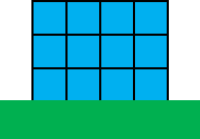BOJ_15573_채굴 (Java)
BOJ_15573_채굴 (Java)
[Gold III] 채굴 - 15573
성능 요약
메모리: 314360 KB, 시간: 1664 ms
분류
너비 우선 탐색, 이분 탐색, 그래프 이론, 그래프 탐색, 매개 변수 탐색
제출 일자
2025년 3월 16일 16:59:34
문제 설명
땅 위에 놓여있는 세로 N, 가로 M 길이의 광산에 1 × 1 광물 N × M개가 있으며, 각 광물은 고유의 강도Si, j를 가진다.
채굴기를 이용하여 이 광물들을 채굴하려고 한다. 채굴기는 공기와 맞닿아 있는 광물 하나를 골라 채굴할 수 있다. 바닥과 광물과만 맞닿아 있으면 채굴할 수 없다. 채굴기의 성능 D에 대해, 채굴기는 강도가 D 이하인 광물들만 채굴할 수 있다. 원하는 광물의 수 K 이상을 채굴할 수 있는 최소의 D를 구하여라.
입력
첫째 줄에 N, M, K가 주어진다. (1 ≤ N, M ≤ 1000, 1 ≤ K ≤ N × M) 둘째 줄부터 맨 위의 광물들부터 순서대로 N줄 동안 M개의 광물의 강도 Si, j가 주어진다.(i = 1, 2, ..., N, j = 1, 2, ..., M) (1 ≤ Si, j ≤ 106)
출력
K개 이상의 광물을 채굴할 수 있는 최소의 D를 구하여라.
문제 풀이
간단한 bfs 문제다. 효율적으로 최소 D값을 찾기 위해 파라매트릭 서치를 사용했다.
코드
1
2
3
4
5
6
7
8
9
10
11
12
13
14
15
16
17
18
19
20
21
22
23
24
25
26
27
28
29
30
31
32
33
34
35
36
37
38
39
40
41
42
43
44
45
46
47
48
49
50
51
52
53
54
55
56
57
58
59
60
61
62
63
64
65
66
67
68
69
70
71
72
73
74
75
76
77
78
79
80
81
82
83
84
85
86
87
88
89
90
91
92
93
94
95
96
97
98
99
100
101
102
103
104
105
106
107
108
109
/**
* Author: nowalex322, Kim HyeonJae
*/
import java.io.*;
import java.util.*;
public class Main {
static BufferedReader br;
static BufferedWriter bw;
static StringTokenizer st;
static int N, M, K;
static int [] dr = {-1, 1, 0, 0}, dc = {0, 0, -1, 1};
static int[][] board;
static boolean[][] visited;
public static void main(String[] args) throws Exception {
new Main().solution();
}
public void solution() throws Exception {
br = new BufferedReader(new InputStreamReader(System.in));
// br = new BufferedReader(new InputStreamReader(new FileInputStream("src/main/java/BOJ_15573_채굴/input.txt")));
bw = new BufferedWriter(new OutputStreamWriter(System.out));
st = new StringTokenizer(br.readLine());
N = Integer.parseInt(st.nextToken());
M = Integer.parseInt(st.nextToken());
K = Integer.parseInt(st.nextToken());
board = new int[N][M];
visited = new boolean[N][M];
int maxD = 0;
for (int i = 0; i < N; i++) {
st = new StringTokenizer(br.readLine());
for (int j = 0; j < M; j++) {
board[i][j] = Integer.parseInt(st.nextToken());
if(board[i][j] > maxD) maxD = board[i][j];
}
}
int left = 1, right = maxD;
int res = 0;
while(left <= right) {
int mid = left + (right - left) / 2;
int count = countMines(mid);
if(count >= K){
res = mid;
right = mid - 1;
}
else left = mid + 1;
}
System.out.println(res);
br.close();
}
private int countMines(int mid) {
visited = new boolean[N][M];
int cnt = 0;
for (int j = 0; j < M; j++) {
if (!visited[0][j] && board[0][j] <= mid) {
cnt += bfs(0, j, mid);
}
}
for (int i=1; i<N; i++) {
if(!visited[i][0] && board[i][0] <= mid) cnt += bfs(i, 0, mid);
}
for (int i=1; i<N; i++) {
if(!visited[i][M-1] && board[i][M-1] <= mid) cnt += bfs(i, M-1, mid);
}
return cnt;
}
private static int bfs(int r, int c, int D){
Queue<int[]> queue = new LinkedList<>();
queue.offer(new int[]{r, c});
visited[r][c] = true;
int cnt = 1;
while(!queue.isEmpty()){
int[] curr = queue.poll();
for (int k=0; k < 4; k++){
int nextR = curr[0] + dr[k];
int nextC = curr[1] + dc[k];
if(isValid(nextR, nextC) && !visited[nextR][nextC]){
if(board[nextR][nextC] <= D){
queue.offer(new int[]{nextR, nextC});
visited[nextR][nextC] = true;
cnt++;
}
}
}
}
return cnt;
}
private static boolean isValid(int nr, int nc) {
return nr >= 0 && nr < N && nc >= 0 && nc < M;
}
}
This post is licensed under
CC BY 4.0
by the author.

